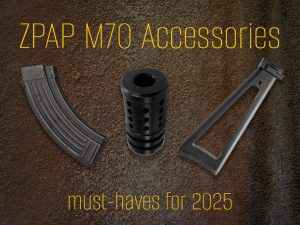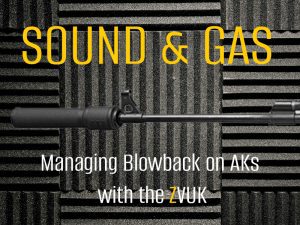You pick up a rifle with a titanium can, and your shoulder smiles first. Titanium silencers drop serious ounces without turning the muzzle into a pogo stick.
The trick lies in titanium’s specific strength: the metal weighs far less than steel yet still carries stout tensile numbers. Grade 5 (Ti-6Al-4V) sits at about 4.4–4.5 g/cm³ and keeps plenty of muscle for hard use, which is why jets love it and your back does too.
Strength-to-weight: why titanium wins the scale
Weight tells a simple story.
Compared with common stainless options, titanium cuts mass by roughly a third while holding strength in the same ballpark for this use case. That ratio matters on gas guns, where a lighter front end speeds transitions and trims fatigue over long range days.
Ti-6Al-4V’s mechanical profile also fits suppressor geometry well: we can run thin walls that still resist denting, and internal structures that stand up to recoil and blast as long as you keep sane firing schedules. We pick Grade 5 because it balances strength, toughness, and corrosion resistance far better than commercially pure grades.
Heat behavior: the real boss fight
Here’s the twist. Titanium doesn’t chase heat across the tube—and that helps you. Ti-6Al-4V sits at ~6.7–7.3 W/m·K, so the can localize heat instead of wicking it into every corner.
You’ll see a quick temp spike, sure, but the lower mass and high-temp emissivity let it drop back fast between strings. Net result: less weight on the muzzle, quicker cooldowns, and balance that actually feels like a rifle, not a dumbbell.
Typical 17-4 PH stainless conducts heat 2–3× better on paper, but you carry more of it. More mass soaks up heat and keeps it longer, and that front weight nudges POI and slows transitions. Titanium trims the lever arm, cuts droop, and keeps mirage manageable with smart geometry or a sleeve when you need it.
Hard runs can push surface temps toward ~600 °C. A well-designed titanium core—with thicker blast features, directional vents, and sacrificial architecture—handles that cadence without drama. Nickel superalloys like Inconel 718 shrug at even higher temps, but the penalty shows up on the scale and in your sights.
Strength-to-weight wins most real shooting. Abuse-only builds can chase superalloys; everyone else gets the better rifle with titanium.
Oxidation, alpha-case, and why red-hot Ti gets grumpy
Heat invites oxygen; titanium sets ground rules. At high temps, oxygen diffuses into Ti-6Al-4V and can form alpha-case—a hard, brittle skin—if you keep the part in the red for long stretches. Short spikes come and go; sustained soaks create problems. Run sane strings and you stay out of that neighborhood while you enjoy the lighter nose, faster transitions, and less POI drift that titanium buys you.
Alpha-case trims ductility and fatigue life when you live at high temperatures. Most shooters don’t. Smart design—thicker blast features, sacrificial sections, surface finishes that slow diffusion—and a grown-up firing schedule keep a Ti can healthy for the long haul. Steel and superalloys avoid alpha-case, sure, but they pay in mass, balance, and handling. Titanium keeps the rifle lively and still takes real work when you manage heat like an adult.
Ignition? Internet myth fuel. Solid titanium needs extreme temperature and oxygen to light—think ~1200 °C or higher. Normal rifle use doesn’t touch that. Could you cook a Ti can? If you chain mag dumps on a short barrel with a hot tailwind, you can cook anything. For everyone else, titanium wins the week: better strength-to-weight, better balance, and plenty of headroom when you don’t turn every range trip into a stress test.
Durability in practice: where titanium shines (and where it doesn’t)
- Rifle, moderate rate: Our titanium silencers crush this lane. You save weight, keep balance, and still enjoy a long life when you keep strings sane and let the can breathe. That low conductivity does create more mirage, so hunters and precision shooters often run a simple cover to push mirage forward.
- Carbines and short barrels: Gas temperature and pressure spike as you shorten barrels or lean on aggressive muzzle pressure. Some designs in the market add a tougher blast feature from a nickel superalloy, then use titanium for the rest to save weight. Our ZVUK takes a different route: a 3D-printed monolithic titanium body with our Purposely Induced Porosity™ (PIP) geometry to manage flow and heat while keeping ounces off the nose.
- Full-auto or “abuse mode”: If you plan long bursts or training blocks that mimic them, nickel superalloys rule for pure heat tolerance, with a weight penalty. Stainless 17-4 PH sits in the middle: heavier than titanium, lighter than full superalloy builds, and resilient enough for most users who avoid meltdown drills. Our guidance stays simple—match material to mission, and don’t outrun physics.
- Precision game: Titanium pairs beautifully with precision rifles. You get a lively muzzle and less fatigue on barricades. Manage heat to control mirage—think “two mags, then cool” on gas guns, or a cover and a small fan during matches.
Additive manufacturing: why many modern Ti cans look so clean
We 3D-print our titanium silencers (like ZVUK) in one piece with DMLS/SLM. Additive builds unlock internal lattices, smooth gas paths, and organic geometry that a mill can’t reach. You also lose joints that could creep or loosen.
This approach fits titanium perfectly because we chase weight savings and smart internal volumes. We rely on CAD-driven lattices, our PIP™ structures, and rigorous QC to keep porosity and surface finish inside spec.
So…should you pick titanium?
Yes—pick titanium. If you hike far, run moderate strings, or care about balance, our titanium cans feel like a cheat code. You drop weight, keep pointability, and get corrosion resistance that shrugs off rain, sweat, and blood.
Respect heat and titanium runs light, quiet, and long. Ignore heat and physics sends the bill—faster mirage, softened threads, shorter life. Your shoulder and your split times vote Ti. Get titanium and go win the week.



